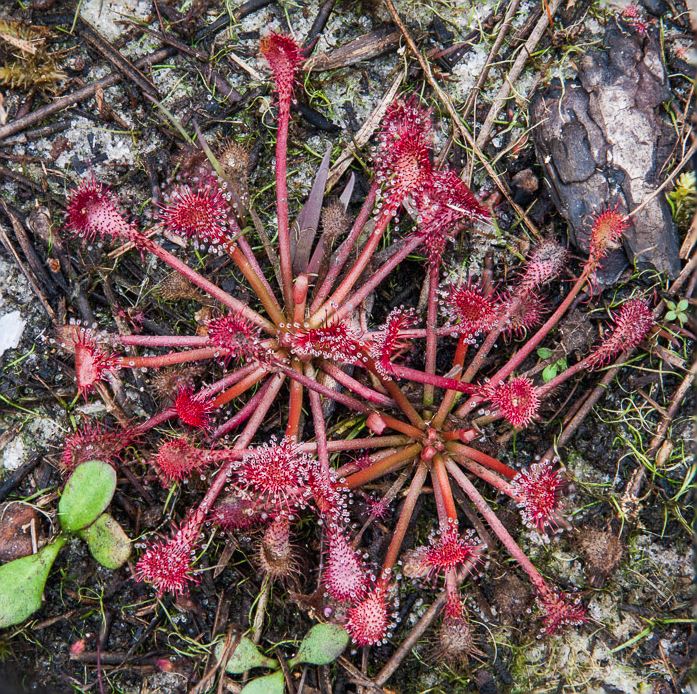Difference between revisions of "Drosera capillaris"
(→Ecology) |
|||
| Line 45: | Line 45: | ||
<!--===Pollination===--> | <!--===Pollination===--> | ||
===Use by animals=== <!--Herbivory, granivory, insect hosting, etc.--> | ===Use by animals=== <!--Herbivory, granivory, insect hosting, etc.--> | ||
| − | Crayfish mound excavations burying individuals of ''D. capillaris'' is one source of mortality, especially in smaller individuals.<ref name="Brewer 1999"/> | + | Crayfish mound excavations burying individuals of ''D. capillaris'' is one source of mortality, especially in smaller individuals.<ref name="Brewer 1999"/> One predator of ''D. capillaris'' is the larvae of the plume moth (''Trichoptilus parvulus'') which emerge at night to consume the stalked gland of the sundew.<ref name="Eisner & Shepherd 1965">Eisner T. and Shepherd J. (1965). Caterpillar feeding on a sundew plant. Science 150(3703):1608-1609</ref> Larger larvae may also consume parts of the leaf blade in addition to the gland.<ref name="Eisner & Shepherd 1965"/> |
<!--==Diseases and parasites==--> | <!--==Diseases and parasites==--> | ||
Revision as of 11:44, 6 December 2017
| Drosera capillaris | |
|---|---|

| |
| Photo by John B | |
| Scientific classification | |
| Kingdom: | Plantae |
| Division: | Magnoliophyta - Flowering plants |
| Class: | Magnoliopsida - Dicots |
| Order: | Nephenthales |
| Family: | Droseraceae |
| Genus: | Drosera |
| Species: | D. capillaris |
| Binomial name | |
| Drosera capillaris Poir. | |

| |
| Natural range of Drosera capillaris from USDA NRCS Plants Database. | |
Common Name(s): pink sundew[1][2]
Contents
Taxonomic Notes
Synonym(s): D. rotundifolia var. capillaris, D. sessilifolia, D. brevifolia var. major, D. minor, D. tenella[3]
Description
D. capillaris is a dioecious perennial forb/herb.[2]
Distribution
Drosera capillaris is found in the southeastern United States ranging from Virginia, south to Florida, and westward to Texas. It can aslo be found in the West Indies, Mexico, and northern South America.[1]
Ecology
Habitat
It is an obligate wetland species[2] being found in pine savannas and other wet sandy or peaty soils.[1]
Phenology
The peak flowering period occurs in April and May and the probability of a rosette flowering is mostly dependent upon its size.[4]
Seed bank and germination
Emergence of seedlings typically occurs between early winter and late spring.[4]
Fire ecology
Fires facilitate the occurrence of D. capillaris by eliminating or reducing competition.[4] Seedling density also increased following burns, although the growth rates of seedlings remained unaffected.[4] Growth rates are instead dictated by level of competition.[4]
Use by animals
Crayfish mound excavations burying individuals of D. capillaris is one source of mortality, especially in smaller individuals.[4] One predator of D. capillaris is the larvae of the plume moth (Trichoptilus parvulus) which emerge at night to consume the stalked gland of the sundew.[5] Larger larvae may also consume parts of the leaf blade in addition to the gland.[5]
Conservation and Management
Cultivation and restoration
Photo Gallery
References and notes
- ↑ 1.0 1.1 1.2 Weakley A. S.(2015). Flora of the Southern and Mid-Atlantic States. Chapel Hill, NC: University of North Carolina Herbarium.
- ↑ 2.0 2.1 2.2 USDA, NRCS. (2016). The PLANTS Database (http://plants.usda.gov, 30 November 2017). National Plant Data Team, Greensboro, NC 27401-4901 USA.
- ↑ Wunderlin R. P., Hansen B. F., Franck A. R. and Essig. F. B. (2017). Atlas of Florida Plants (http://florida.plantatlas.usf.edu/).[S. M. Landry and K. N. Campbell (application development), USF Water Institute.] Institute for Systematic Botany, University of South Florida, Tampa.
- ↑ 4.0 4.1 4.2 4.3 4.4 4.5 Brewer J. S. (1999). Effects of fire, competition and soil disturbances on regeneration of a carnivorous plant (Drosera capillaris). American Midland Naturalist 141:28-42.
- ↑ 5.0 5.1 Eisner T. and Shepherd J. (1965). Caterpillar feeding on a sundew plant. Science 150(3703):1608-1609